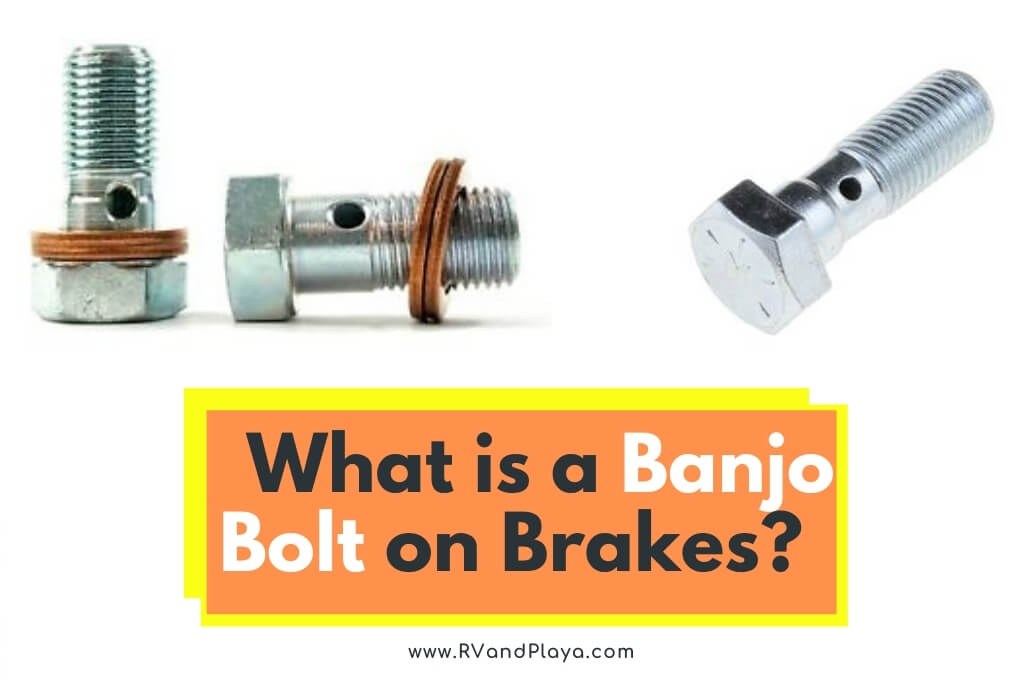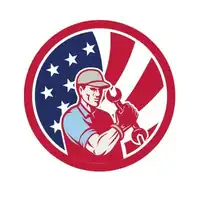Your banjo bolt may be small, but it serves a rather important role in the functioning of your car braking system. However, not many people know precisely what role the iconically named bolt does in their car.
So, what is a Banjo bolt on brakes? A banjo bolt on brakes is part of a banjo fitting, a form of internal relief bolt that facilitates the transfer of brake fluid from the brake pedal to the calipers and cylinder of a hydraulic brake system. The banjo bolt is perforated and releases into a spherical reservoir to transfer fluid under high pressures.
Banjo bolts aren’t limited to braking systems and play a role in automotive fuel, motor oil, and hydraulics.
If you want to know what a banjo bolt is and how it works in your brake system, here’s its function and role explained.
Table of Contents
What is a Banjo Bolt on Brakes?
A banjo fitting is a specialized compressed washer consisting of a hollow perforated banjo bolt and a spherical fluid transfer union to transfer fluid.
They are typically used in high-pressure fluid systems such as the clutch and brake systems in the automotive industry.
In a car braking system, the banjo fitting is used to attach a hose or tube to a port on a cylinder or caliper at a close right angle.
Fluid passes from the brake line into the cutaway section inside the banjo fitting and through the hollow banjo bolt to the cylinder or caliper.
The banjo bolt is designed to withstand greater than 50 psi pressures, making it perfect for transferring the pressurized fluid between the brake fluid lines to the brake cylinders.
Banjo fittings are tightly sealed at either end with copper crush washers. Copper crush washers are made of annealed copper, which is very soft and requires very little torque to create a watertight seal.
Once you tighten the banjo bolt, it creates a sealed passage where the brake fluid can move through the side of the bolt.
Banjo fittings also have the advantage of being moved independently of the host fitting, preventing damage to the hose while screwing the fitting in place.
This feature gives flexibility in hose attachment and positioning relative to the engine interior.
Banjo bolts with their copper crush seals allow the brake fluid to pass around the bolt without the holes aligning like a regular thread fitting.
In this way, they facilitate the installation of flexible lines in your brake system.
Why you should always install new Banjo Brake line Crushwashers >> Check out the video below:
What Does a Banjo Bolt Do?
The banjo lt forms an attachment point between the brake lines and the cylinder in response to the brake pedal operation.
It is an integral part of your braking system that regulates the transfer of brake fluid. In particular, the functioning of the banjo bolts the working of your brake calipers.
Your brake calipers are crucial for your brake function, and you will find them on each wheel. They work to squeeze the brake pads against the rotors to slow the spin of the wheel.
Calipers are made up of several working parts, including the banjo fitting.
Brake fluid is fed to the caliper through the banjo fitting feeds the fluid to the caliper, which moves the piston towards the inner brake pad when you press the on the gas pedal.
The caliper then moves along a system of slide pins which draws the outer brake pad against the disc rotor in the brake.
Is The Banjo Bolt Important?
Maclaren recalled 19 of their vehicles due to a faulty banjo bolt in cars issued between July 8, 2019, and March 15, 2020.
Luckily for the drivers, the Mavchlarens electronic stability control made up for the faulty break with the other three functioning brakes.
The banjo bolts play a role in fluid transfer under high pressure, especially in hydraulic brake systems.
Your banjo fitting and bolt regulate the flow of brake fluid under pressure, and it is the brake fluid that activates the braking mechanisms.
The pistons cause the brake pads to slow the car. Without the fluid passing under proper pressure through the banjo fitting, the pistons won’t captivate properly to apply the pads to the discs and rotors.
Banjo Bolt FAQ
Do Banjo Bolts Need to Be Replaced?
Like any component in a working vehicle, the part will reach the end of its lifespan at some stage.
The exact duration depends on several variables, but a great way to check it is to take out the bolt and examine the banjo bolt holes.
If the holes in the banjo bolt look elongated, then it is time for you to replace them. It should be a perfect circle on the cross-drilled holes.
Must You Line up the Holes Of a Banjo Bolt?
No, you don’t need to align with the hole in the banjo fitting. The beauty of the banjo fitting design is that the banjo fitting offers a ready-made spherical reservoir to feed the fluid from the perforated bolt.
The system gives more flexibility in terms of independent hose movement and maneuverability.
Why is it Called a Banjo Bolt?
Americans, in particular, call the banjo fitting (and by association the bolt) as such due to the pronounced spherical head of the fitting usually accompanied by a thin connection point.
The round head and neck are evocative of an old-fashioned banjo.
How Many Washers Do You Need For a Banjo Bolt?
You will need two copper crush washers on each side of the banjo fitting. Although you can technically reuse your copper crushes, most experts advise against reuse.
To properly reuse a crush washer, you need to re-anneal your copper crush washer under high heat. Crush washers are relatively inexpensive, so you really should consider buying new ones.
What Kind of Washers Must I Use for my Banjo Bolt?
Typically banjo bolts take copper crush washers on either side of their connection points. Copper crush washers soft metal deforms when tightened to fill any gaps where liquid may seep through the banjo bolt.
Copper is ductile, and its malleable nature conforms to the shape of its attachments to ensure a liquid-tight seal. The seal is particularly important in high-pressure systems such as hydraulic brakes.
How Do I Measure for a Banjo Fitting?
When replacing your banjo fitting, you need to use a thread gauge to determine if the threads are metric or standard.
A thread gauge will determine whether the threads are fine, coarse, metric, or standard. The torque specifications are contingent on your specific application.
You would need a set of calipers to measure the bolt diameter and pipe diameter to ensure you have the correct size fitting.
You would need to measure the pipe height and inside diameter ID, the bolt, height, and OD outside diameter.
How Much Do Banjo Bolts Cost?
Banjo bolts, like most motor parts, vary in price between aftermarket and OEM quality. Prices range between $9 to $24 from Amazon.
Typically the bolt comes with the copper crush washers included in the price. If you struggle to find a replacement banjo bolt, you may need someone to customize a bolt to your specifications which will obviously increase the price.
How Tight Should a Banjo Fitting be Turned?
When tightening a banjo bolt, you need to ensure that the flare conforms to the fitting to achieve a proper seal. Some experts suggest tightening the fitting, then back off and tighten it several times to get a proper seal.
Hose and Fittings offer Banjo Bolt Torque Specifications for tightening torque on various size banjo fittings.
Otherwise, most forums agree that the fit should be snug without being overly tight. Overtightening your banjo fitting will cause the copper washers to fail and leak during driving.
Why My Banjo Fitting is Leaking?
Before you install your banjo fitting you should always ensure that you clean your mating surfaces properly. A small metal burr or deformity could prevent your banjo from seating properly.
Make sure that your crushers are not worn or damaged and there are two crush washers on either end of your banjo fitting.
Lastly, make sure your banjo fitting seats down on the caliper surface correctly.
Conclusion
Although a banjo bolt and fitting may seem small, they serve an essential purpose in your vehicle brake system.
If you decide to replace your banjo bolt, always ensure that the bolt is the correct size and replace the copper crush washers at the same time.
The copper crushes may deform over time and lose their malleability.
Here are some of my favorite tools & equipment´s
Thank you for reading this article. I hope it helps you find the most recent and accurate technical and repair information for your car. Here are some tools that I use as an automotive technician and hope you´ll also find helpful.
There are affiliate links, so if you do decide to use any of them, I´ll earn a small commission. But in all honesty, these are the exact tools that I use and recommend to everyone, even my own family. (NO CRAP)
To see all my of most up-to-date recommendations, check out this resource that I made for you!
References
https://www.hoseandfittings.com/banjo-torque/
https://www.speedwaymotors.com/
Recent Posts
Toyota Highlander Brake Controller: 13 Helpful Tips (Explained)
Looking for Toyota Highlander brake controller? The Toyota Highlander is a fantastic towing vehicle. However, as you may well know if you want to tow safely, then you need to have a brake...
Have you ever wondered how to set a trailer brake gain? Look no more. We´ve got you covered. If you own a trailer brake controller, then you will need to become very familiar with the term...


